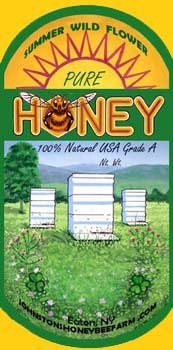This operation has originated two different beehives: the Two Colony Hive and the Combination Queen Rearing Nucleus and Comb Honey Hive.
At this time, we are not selling this equipment. Past atempts at equipment production have not proven profitable. We have found it is more productive to use this equipment to produce bees for sale to other beekeepers.
The Two Colony Hive is well tested. Johnston’s Honeybee Farm received a 2001 Sustainable Agriculture Research and Education Grant to test this hive and compare its productivity with the standard 10 frame Langstroth hive. This grant was completed in 2004. During the course of this project, standard hives overwintered an average of 0.71 clusters of bees (71%) while the two colony hives averaged 1.49 clusters per hive successfully overwintered. Two colony hives were mainly used to produce nucs and brood for sale to other beekeepers. In 2004, a pair of two colony hives were used primarily for honey production. These two hives averaged 357 pounds surplus of honey and wax each. The eight highest producing hives in our operation averaged 151 pounds. The final report for this grant is a separate page on this web site.
The Combination Queen Rearing Nucleus and Comb Honey Hive has proven to be a more difficult hive to use than the Two Colony Hive. Honeybees do not thrive on the smaller frames employed in this hive or the ”baby” nucs employed by bee breeders. Lorenzo Langstroth’s favorite frame was actually the jumbo deep, deeper than our standard deep frame. In 2017 we redesigned the hive to use a slightly bigger frame and fewer compartments in the hive. Overwintering for this hive is more difficult than for a hive using standard frames. Hive bodies are compatible with the Two Colony Hive and those hives can be used to produce the smaller brood frames in the Spring. We continue to work on overwintering.

